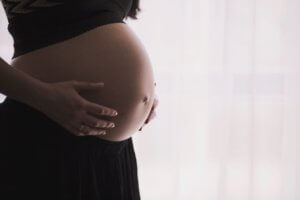Contractions are quite normal as pregnancy progresses. But what happens if the contractions start too early? It is not always immediately clear whether the contractions are inducing labor. Nevertheless, rapid action is required even if it is suspected.
After all, avoiding a premature birth is paramount. Preterm labor can often be treated quickly and easily using modern methods. Here you can find out what tocolysis is and when it is used.
Table of contents
What Is A Contraction?
Labor contractions are those muscle contractions of the uterus that ultimately lead to birth. The clear characteristic of contractions compared to other symptoms that may occur during pregnancy is their clear distinction from each other.
There is also a pause between painful contractions, during which the discomfort almost or even completely disappears.
In addition to labor pains, which occur at the end of pregnancy, there are other types of contractions that can occur throughout pregnancy, but especially as early as the 28th week of pregnancy. Some of these are barely noticeable to you, but on the other hand can be painful enough to get your attention.
How Is Labor Measured?
As your pregnancy progresses, the role that contractions play in checkups increases. That’s why something called cardiotocography (CTG) is a routine checkup during pregnancy.
When it is used also depends on your personal course of pregnancy. If you have a high-risk pregnancy, you will probably be checked for contractions by CTG as early as the 24th week of pregnancy.
Otherwise, it is usual to have a CTG from around the 28th week of pregnancy. During a cardiotocography, two values are determined simultaneously. Both a possible contraction and the baby’s heartbeat are recorded at the same time.
Fetal movements can also be detected on the CTG. In addition to traditional stationary CTG sensors, wireless sensors are also in use today that allow you to move freely. They are usually also used to monitor contractions during childbirth.
What Types Of Contractions Are There?
It pulls uncomfortably in the abdomen, but is over in a moment? During pregnancy, it is not always possible to clarify beyond doubt whether such a sensation was not a premature, cervical contraction.
In fact, contractions can occur from about halfway through pregnancy, and in some pregnant women even earlier. Most pregnant women have experienced contractions by the 28th week of pregnancy. However, these are usually harmless contractions. This overview explains the different types of contractions.
Practice Contractions
You have just celebrated the “mountain party” of your pregnancy, and suddenly your belly becomes hard and causes an unpleasant feeling of pressure? It is quite possible that this has already been an exercise contraction.
Exercise contractions are also called Braxton-Hicks contractions and can occur as early as the 24th week of pregnancy, sometimes even a little earlier. A characteristic feature of exercise contractions is that the entire baby bump becomes hard and remains so for a certain period of time.
Many pregnant women experience an unpleasant, constricting feeling of pressure at the same time. This is completely normal from the 28th week of gestation. Such exercise contractions are often equated with abdominal pain.
As quickly as they come, these exercise contractions normally go away. Their purpose is to train the muscles of the uterus, so to speak, and make them fit for birth.
You should always be careful if you have severe pain at the same time or if the exercise contraction lasts longer than a minute. In this case, you should have the condition clarified by your gynecologist or a midwife.
Special care should be taken if you are still before the 24th week of gestation, as extreme prematurity is to be expected then. An examination can rule out the possibility that the exercise contraction is causing shortening of the cervix, which would be a reason for tocolysis.
The closer you get to the end of your pregnancy, the better you will get to know the exercise contractions. From the 36th week, Braxton-Hicks contractions increasingly turn into preterm labor.
Preterm Labor
Preterm labor starts around the 36th week, but some expectant mothers feel it as early as the 28th week. They are similar to the Braxton-Hicks contractions you are already familiar with. However, some preterm contractions are already much more unpleasant or painful.
The aim of preterm labor is to push your baby deeper into the pelvis and bring it into a birth position. This lowers the abdomen, which is also clearly visible from the outside. This has the advantage of giving you more freedom of movement, at least until the next growth spurt.
Complaints such as shortness of breath or heartburn may also improve for some time. These preterm labor pains are also known as contractions. They occur at irregular intervals, which clearly distinguishes them from labor pains.
Opening Contractions
You’re still two weeks away from your due date, but you’re already feeling regularly recurring contractions? If they have not disappeared after half an hour, they may already be opening contractions.
The opening contractions mark the end of your pregnancy and are a clear sign of the beginning of labor. They occur so regularly that you can measure their interval with a stopwatch. At the beginning of the opening phase, seven to ten minutes may pass between contractions.
Over the course of the next few hours, however, the interval shortens to just a few minutes. They not only increase in frequency, but also in strength. At the latest when the interval between contractions is only five minutes, or you can no longer talk to your partner during a contraction, you should make your way to the hospital.
The aim of opening contractions is to open your cervix to a width of ten centimeters so that your baby’s head can pass through.
Compression Contractions
This type of labor pushes your baby out of the vagina at the end of the opening phase. Only now is the moment when you can actively support your body by pushing. Pressing contractions to build up a strong pressure that you cannot escape. This is the final spurt of your birth, which can last between 20 to 40 minutes.
Postpartum Contractions
Even after the birth, you will not be spared contractions for the time being. Postpartum contractions can occur as early as half an hour after birth and again and again over the next few days. Their purpose is to detach and expel the placenta.
Contractions accompany the regression of the uterus and help it to return to its original size. Postpartum contractions are particularly noticeable in mothers who have already given birth.
Because they very often occur during the first days of breastfeeding, they are also known as lactation contractions. The hormones released during breastfeeding additionally stimulate involution and thus contraction of the uterus.
What Is Tocolysis?
Contractions during pregnancy can be perfectly normal, but if there are any abnormalities, rapid action is required. Until the 34th week of pregnancy, the onset of labor must be delayed as much as possible, even if your baby already has a very good chance from the 28th week.
If there is contractions that need to be stopped, tocolysis is used. This involves various medications that inhibit labor. The contractions are stopped, which allows the baby to mature further.
Prolonging pregnancy is the key indication for the use of tocolytics. Once you reach 34 weeks gestation, your baby is considered medically mature enough that tocolysis is no longer necessary.
Appropriate medications are then discontinued and you are allowed to give birth on your own. In some cases, tocolysis is even used during natural birth. In this case, however, the aim is usually to reduce the baby’s distress.
This is the case if the cervix has not yet fully opened at the beginning of the expulsion phase. A birth that has already begun can also be interrupted by administering tocolytics.
Overview Of Tocolysis Drugs
To delay the onset of labor ideally until after 28 weeks’ gestation, there are numerous medications on the market that are suitable for use in a variety of indications related to preterm labor. The following are among the most common medications.
- Prostaglandin inhibitors
- Calcium channel blockers
- Oxyticin receptor antagonists
- Beta-sympathomimetics
- Indometacin
- Magnesium sulfate
- NO donors
It is also common to use off-label medications for tocolysis in the hospital. This involves the use of medications to eliminate labor that have this effect but are not primarily used for tocolysis.
The Causes Of Tocolysis
Contractions that shorten the cervix and begin between the 22nd and 34th SSW are an acute emergency and already an indication for the administration of tocolysis. At this point, your baby is still an extremely small premature baby and urgently needs every day it can spend in your belly to mature.
There are many causes of premature birth. Such premature contractions are very often associated with cervical weakness. This is when your cervix is significantly shorter than it should be for your gestational week.
In most cases, the cervix is also soft and may already be partially open. But there may also be other causes of premature labor. Infections, such as vaginal or bladder infections, have the potential to trigger labor and therefore need to be treated as soon as possible.
If the infection spreads to the amniotic sac, this endangers your baby on the one hand by the germ load and on the other hand by triggering labor. Premature rupture of the membranes is also a clear signal for tocolysis.
The aim here is to delay the onset of labor as much as possible in order to promote the baby’s lung maturation. It also buys time to transfer you to a special hospital with a premature infant unit if necessary.
Gaining valuable time is absolutely critical for your baby in this situation. Even for very small premature babies between SSW 24 and 28, the start in life can be improved in this way.
The time during tocolysis is used to stimulate the baby’s alveoli to mature quickly with a lung maturation injection. This also means a less complicated stay in the premature care unit in the event of premature birth.
Where Is Tocolysis Performed?
Tokolysis is always performed under strict medical supervision. The appropriate medications are administered in the hospital, and a period of 48 hours is usually estimated. However, depending on the individual situation, this period may be extended, because a premature birth should be delayed as much as possible under all circumstances.
During this time, you must remain on strict bed rest. If you have an infection that could be responsible for premature labor, it will be treated at the same time in order to eliminate the actual cause of labor.
In most cases, antibiotics are used. Studies have now shown that successful antibiotic treatment of the infection causing labor has a significant impact on delaying the birth. It makes a big difference to your baby whether he or she is born at 28 SSW or 30 SSW.
What Happens After Tocolysis?
Early labor does not always lead to birth. If you are treated in time in the hospital, the chances of success are very high. However, the doctors will decide when you can return home based on your individual situation.
Quite a few expectant mothers have to stay in the hospital for some time after tocolysis until the baby has matured further, even if it has already reached 28 weeks gestation. However, it is not uncommon to be discharged home after successful tocolysis and the end of labor.
Here, however, rest and bed rest await you. However, the familiar surroundings are a welcome change from everyday hospital life. You can relax better and prepare for the birth of your baby.












